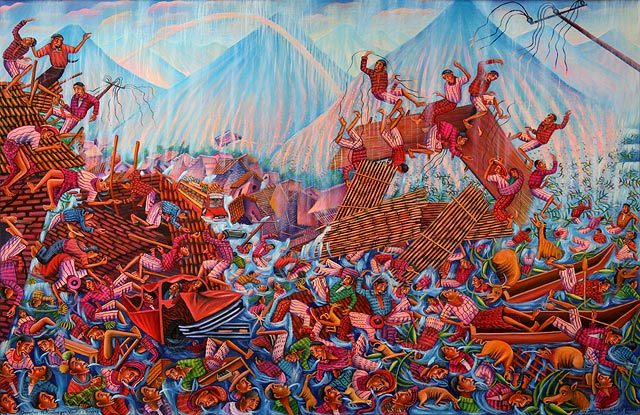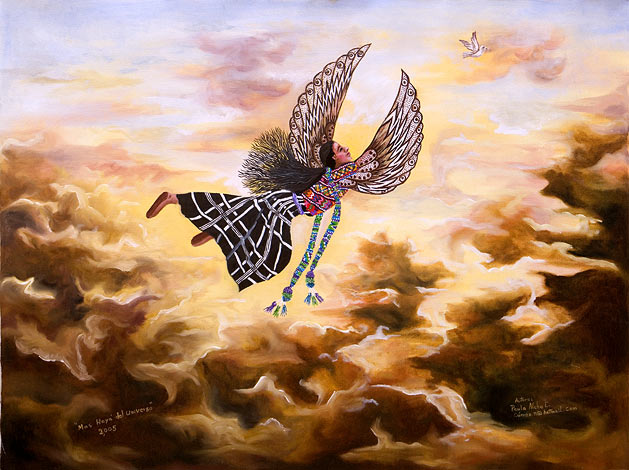
|
|
| .
|
|
| .
|
 |
| .
|
|
|
|
 |
| . |
This painting, by
Diego Isaias Hernandez Mendez, was originally painted after two
hurricanes, Mitch and Stan, devestated areas of Central America. It,
however, illustrates the popular misconception of what will happen when
the current B'aktun ends on December 21, 2012. |
| |
|
| . |
|
| |
When the current B'aktun of the
Maya calendar ends December 21, 2012, will it be the end of the world or
will it be something different? Arte Maya is asking the question
of people who are experts in the Maya calendar and/or Maya spiritual
beliefs. On this evolving page we will post what they think. |
| |
|
| |
Sandra Noble, Executive Director
FAMSI (Foundation for the Advancement of Mesoamerican Studies).
"For the ancient Maya, it was a huge celebration to make it
to the end of a whole cycle." 2012 as doomsday or cosmic shift is "a
complete fabrication and a chance for a lot of people to cash in."
|
| |
| Ajpub’ García,
Tz'utuhil Maya. Mayan linguist and investigator of Maya religious practices.
The thirteenth B’aktun
(Year 2012 in the Gregorian calendar)
In linguistic terms the B’aktun tell us more than
144,000 days equals 400 years. Taking the word B’aktun apart, helps
show the meaning. B’ak = bone, hard. Tun =
rock, to establish, to plant, to put in place. Its overall
significance is the putting in place or beginning of a new event.
The grandmothers and grandfathers Maya have a
saying that they told their descendants Our sons and daughters,
we are going, but we will soon return. In these wise words, they
have said all, that we will not disappear, but are there
accompanying our children and grandchildren through teaching and
practice of Spirituality. The grandmothers and grandfathers Maya
achieved through the use of the Spiritual (Tz’olkin) and Material
(Haab) calendar for the prognosis for levels of events happening in
time and space, principally through the occurrence of the galactic
movements. One example of this, that the sun revolves around a
larger sun, that it takes 26,000 years it one revolution. In other
words the galactic day is 12,500 days and 12,500 nights. Now we are
in the dawn of a galactic day. This means we're at about 3 am before
dawn and celebrating the great event of the changes of positions of
the constellations.
These changes are not the misguided or
misunderstood final prophecies, or end of the world. The
grandparents never mentioned the end of the world. What worked and
continues working for the children and grandchildren is the
prognosis of change. And these changes already happening, such as
global warming and the contamination of large international
companies. Yes, Ba’ktun 13 will bring many changes in the world and
not only among the Maya people. But not the end of the world as is
being popularly proclaimed today.
|
Ajpub’ García,
Tz'utujil Maya. Linguistico maya y investigador de las prácticas religiosas
de los mayas.
El Oxlajuj B’aqtun
(2012 año gregoriano)
En términos lingüísticos el B’aqtun, nos dice mucho
aparte de que nos indica 144,000 días que equivale a 400 años.
Desglosando el término B’aqtun, nos indica que B’aq- = hueso,
duro. Tun = piedra, sentar, sembrar, colocar. Su gran significado,
dice la colocación o inicio de un nuevo acontecimiento.
Las abuelas y los abuelos mayas dejaron dicho a sus descendientes
que Nosotros hijos e hijas, nos vamos, pero pronto regresaremos.
En estas sabias palabras, dejaron dicho todo, que no desaparecieron,
sino que ahí están acompañando a sus hijos y nietos mediante la
enseñanza y la práctica de la Espiritualidad. Las y los abuelos
mayas, lograron mediante el uso del calendario Espiritual y Material,
el pronostico de los grades acontecimientos que sucede en el tiempo
y espacio, principalmente en los acontecimientos de los movimientos
galácticos. Ejemplo de ello han contabilizado, que el sol gira
alrededor de un sol más grande, que tarda 26,000 años para terminar
una vuelta. En otras palabras el día galáctico es 12,500 noches y
12,500 días. Ahora estamos en el amanecer de un día galáctico. Esto
quiere decir, que estamos aproximadamente a las 3 de la mañana, para
que amanezca y celebrar el gran acontecimiento de cambios de
posiciones de las constelaciones.
Estos cambios no son los mal llamados o mal usados términos
Profecías o el fin del mundo. Los abuelos nunca mencionaron fin del
mundo. Lo que trabajaron y siguen trabajando los hijos y nietos es
el pronóstico de los cambios. Y estos cambios ya se esta dando, como
el calentamiento Global y la contaminación de las grandes empresas
en el mundo. El 13 B’aqtun, Sí nos traerá muchos cambios, en el
mundo y no solamente dentro del pueblo maya. Pero no el fin del
mundo como el populismo esta anunciando hoy en día.
Las y los abuelos Mayas nos dejaron dicho, “Continuad vuestro camino
y vereis de nuevo el lugar de donde vinimos” Popool Wuuj.
|
|
| |
Wikipedia: 2012 phenomenon.
This article contains a lot of good information about the Maya, the
Maya calendar, and 2012.
December 2012 marks the ending of the current b'ak'tun cycle of the
Mesoamerican Long Count calendar, which was used in what is now Central
America prior to the arrival of Europeans. Though the Long Count was
most likely invented by the Olmec, it has become closely associated with
the Maya civilization, whose classic period lasted from 250 to 900 AD.
The classic Maya were literate and their writing system has been
substantially deciphered, meaning that a corpus of their written and
inscribed material has survived from before the European conquest.
The Long Count set its "zero date" at a point in the past marking the
end of the previous world and the beginning of the current one, which
corresponds to either 11 or 13 August 3114 BC in the Proleptic Gregorian
calendar, depending on the formula used. Unlike the 52-year calendar
round still used today among the Maya, the Long Count was linear, rather
than cyclical, and kept time roughly in units of 20, so 20 days made a
uinal, 18 uinals, or 360 days, made a tun, 20 tuns made a k'atun, and 20
k'atuns, or 144,000 days, made up a b'ak'tun. So, for example, the Mayan
date of 8.3.2.10.15 represents 8 b'ak'tuns, 3 k'atuns, 2 tuns, 10 uinals
and 15 days since creation. Many Mayan inscriptions have the count
shifting to a higher order after 13 b'ak'tuns. Today, the most widely
accepted correlations of the end of the thirteenth b'ak'tun, or Mayan
date 13.0.0.0.0, with the Western calendar are either December 21 or
December 23, 2012.
Read more on
the Wikipedia page.
|
| |
 |
| |
This painting "Mas
Haya del Universo" [Further out in the Universe] by Paula Nicho Cumes
illustrates more clearly the idea most Maya have about what the change in
the calendar signifies. |
| |
|
| |
Gaspar Pedro Gonzalez,
Maya author and member of the Guatemalan Ministry of Culture.
From the book 13 B’aktun, Maya Visions of 2012 and Beyond (to
be published by North Atlantic Books in the summer of 2010).
Excerpt from the Introduction:
"As we face the approach of 13 B'aktun from the perspective inherited
from Mayan ancestors, the present text invites us to pause along our
journey to assess the human contributions in guiding spaceship Earth and
to ask ourselves, 'Will the Earth always have life? What will become of
the human race once this ship has sailed and its energies are
extinguished, as happens with all living beings?' Only human beings
collectively have the answer."
Excerpt from Chapter One:
"My son, for a long time we Maya have been ignored. We
have been forgotten by the world. They have invented that our ances-
tors returned to who-knows-what constellation of the universe, very far
off, so as to not recognize our existence and rights here on Earth.
Before the arrival of the ajq'axepa', the 'ones from the other side of
the sea,' the foreigner, our elders penetrated the depths of the
universe's secrets. They sat at the table of great sages, great
thinkers, the fathers and mothers of the mysteries of space and time.
They had access to knowledge now hid- den from the majority of human
beings. We ourselves have been led astray from the true path, the trail
of our ancient ancestors, after the invasion to which we were
subjected...
"The ancient knowledge was snatched away from us and substituted with
elements imposed from the other culture, but our knowledge did not
completely disappear.. ..Now the moment has arrived. It is our job to
speak and reveal the secrets so that all humanity, all people of good
will, might know them."
|
| |
Aluna Joy Yaxkin,
spiritual teacher, Sedona, Arizona:
The Maya have a saying "Uk'ux kaj - Uk'ux Ulew". It means "from the
Heart of the Heavens to the Heart of the Earth". This Maya saying is
becoming more than merely a prayer from Mayan tradition, but an actual
physical, cosmic event. We are about to bridge Heaven and Earth; not
only from within us, but also physically in our solar system.
When astronomers view the galaxy from the side, and draw an imaginary
line along the length of it, this is called the plane of the galaxy or
the galactic plane. The line is used as a co-ordination system for
astronomers. The galactic plane is the most densely populated part of
our galaxy. Several sources say that our solar system crosses the
galactic plane about every 65 million years or so. Some say that our
next passing will be in 2012 . . . the Maya Calendar cosmic cycle,
reboot date.
The Maya know that the Milky Way is the galactic plane. The Maya also
understand that 2012 is an ending of an old age and the beginning of a
new, enlightened age. They understood the universe is serpentine in
nature. In other words, the universe undulates! Scientists understand
that the Sun and the Earth wobbles up and down, going back and forth
through the galactic plane. They call this the "galactic carousel"
effect. Just as the serpent undulates… so does Earth and humanity!
Read
the rest of this article on Aluna Joy's website along with other
articles on the Maya Calendar.
|
| |
|
| |
|
| |
|
| |
|
| |
|
| |
|
| |
|
| . |
|
|
|
To contact us write: Arte Maya Tz'utuhil, P.O. Box 40391, San
Francisco, CA 94140. Telephone: (415) 282-7654.
Email me at

All paintings and photographs Copyright © 1988–2015 Arte Maya Tz'utuhil
Todas pinturas y fotografías son Derechos Reservados © 1988–2015 Arte Maya Tz'utuhil
|


